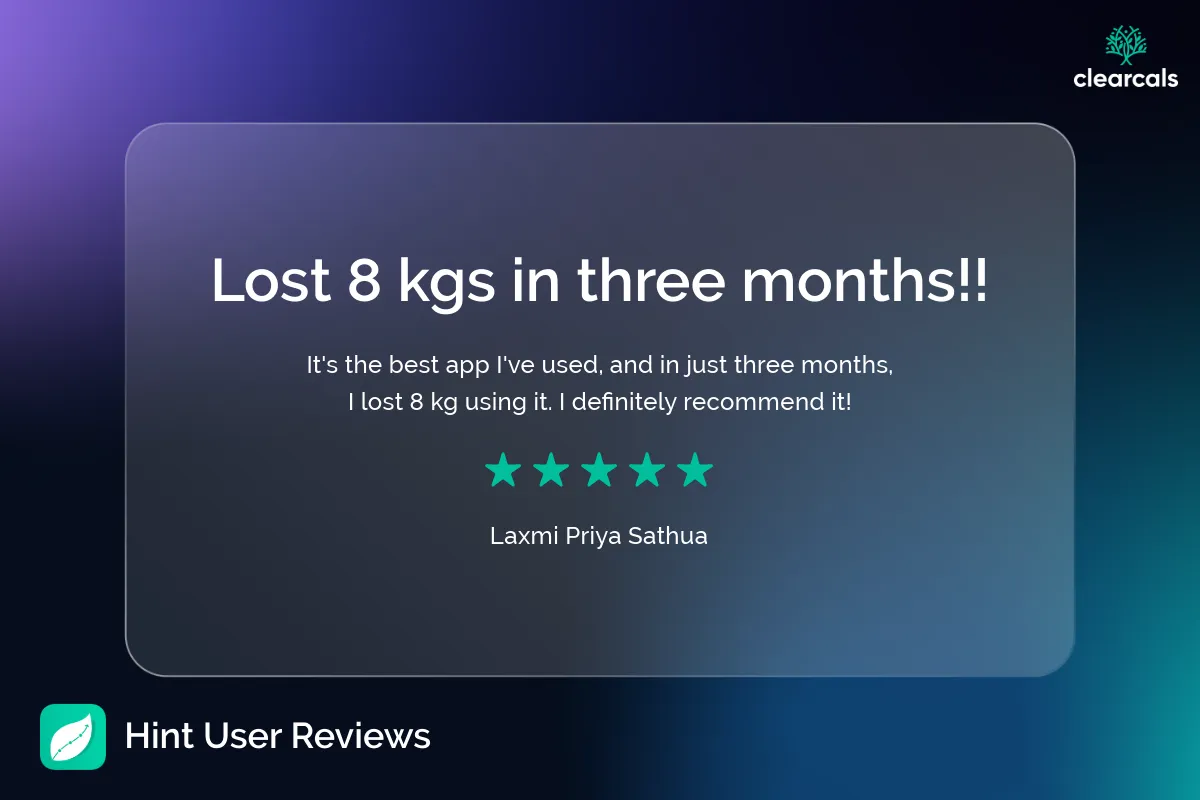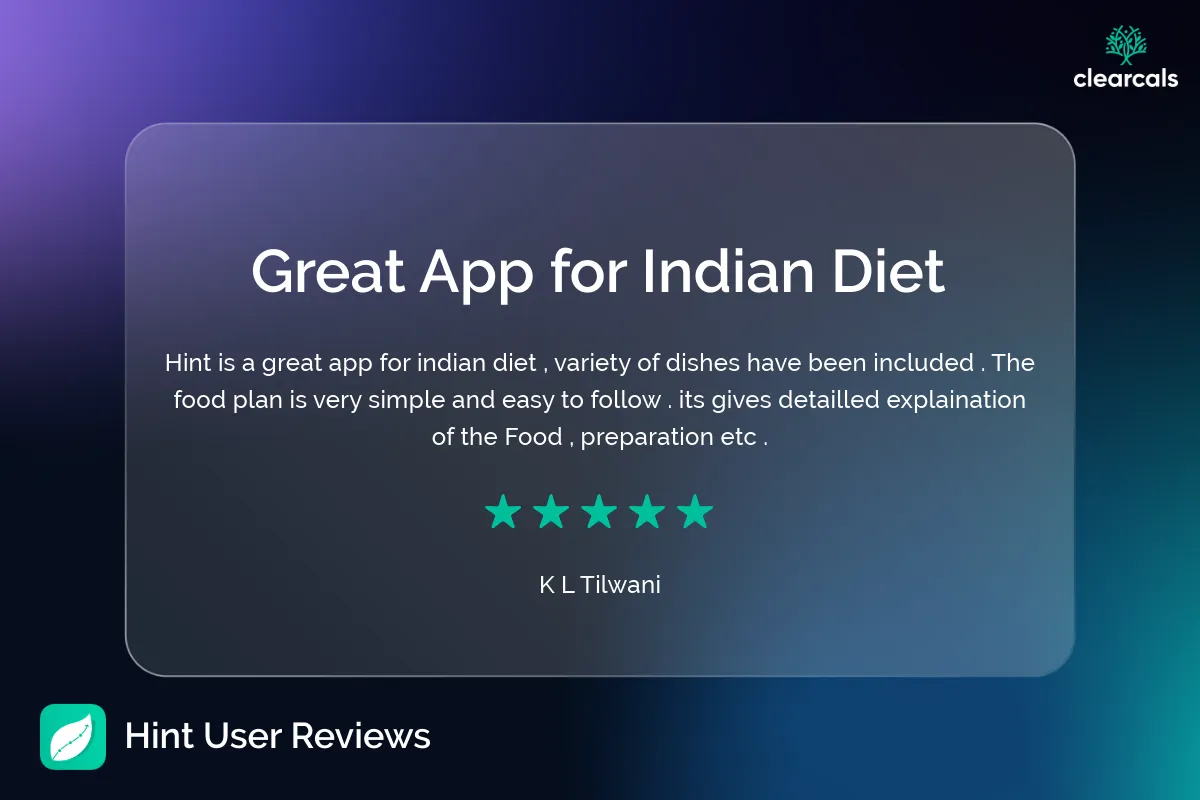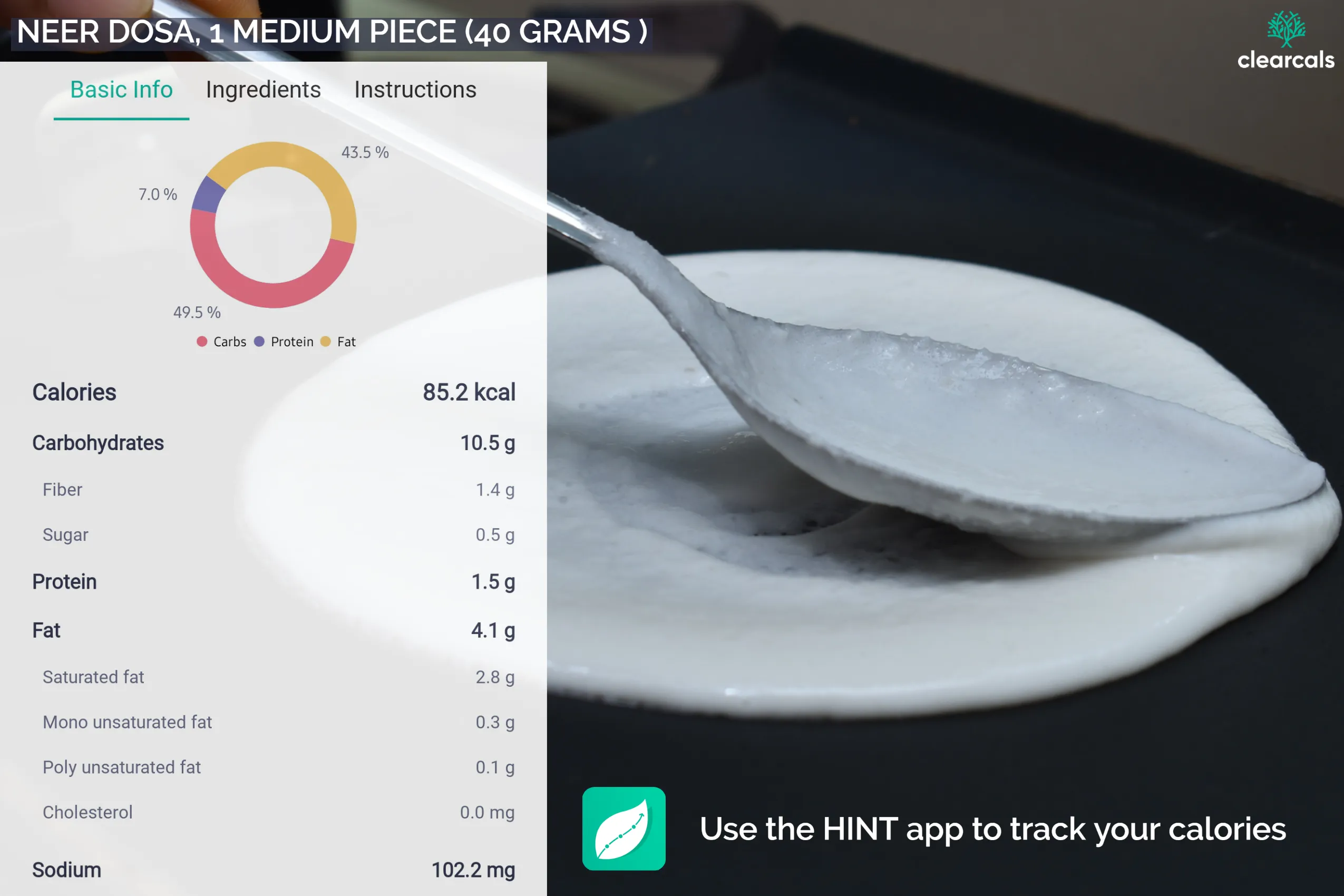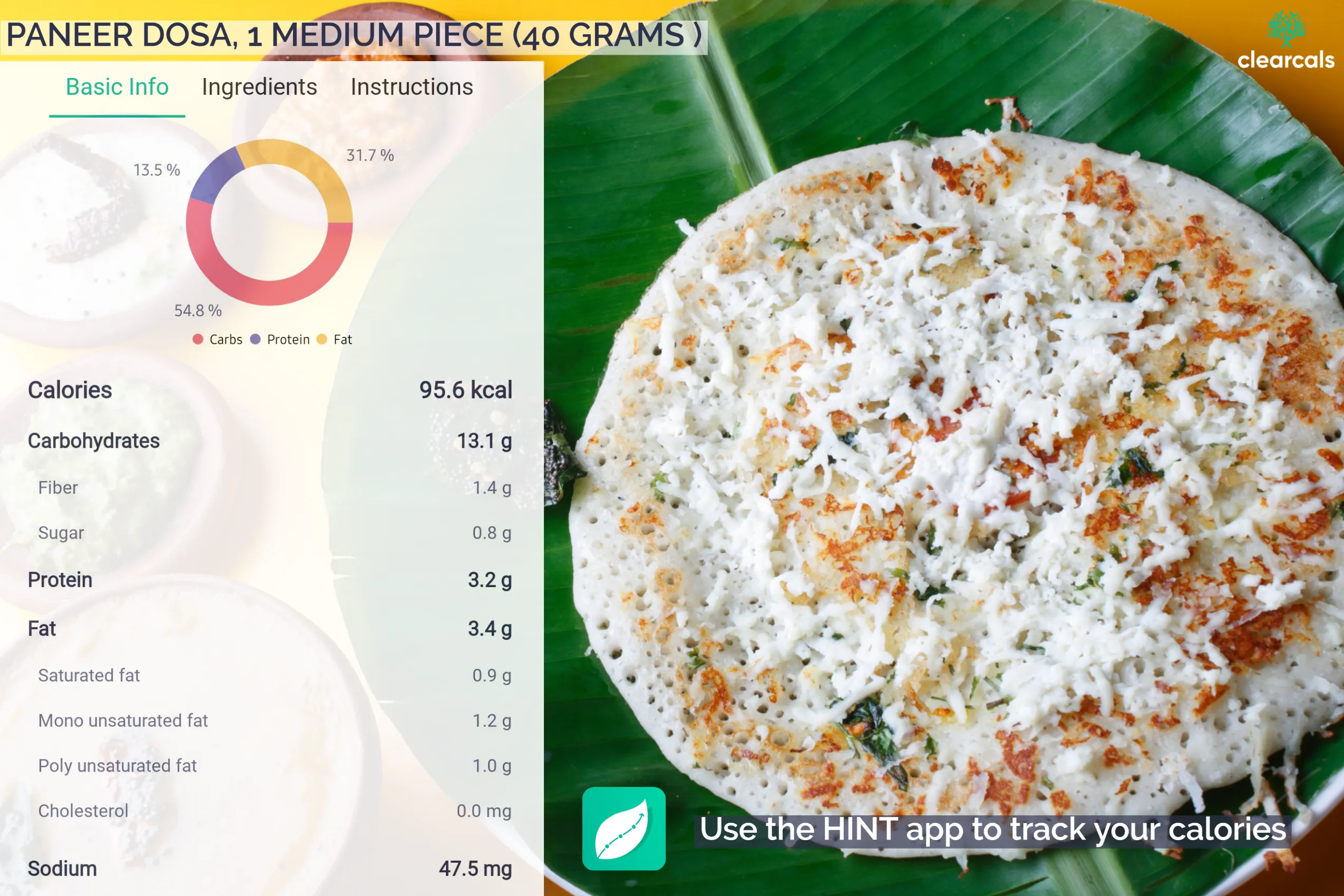Looking for a Personalized Diet Plan?
Dosa Calories, Nutrition, and Health Benefits

Written by Asfia Fatima, Chief Dietitian at Clearcals
TL;DR
- One medium plain dosa contains 104 kcal, but the calorie count can vary depending on the size and recipe.
- Dosa is a good source of carbohydrates and protein, and when paired with healthy fats, it can support weight loss and help manage conditions like diabetes.
- However, moderation is key, as dosa is relatively high in calories.
Plain Dosa Calories
One medium piece (40 grams) of plain dosa has 104 kcal.
Calories in a dosa depend on the recipe, serving size, or quantity in grams. Here is a table of how calories increase with serving size and the number of dosas.
| Dosa Serving Size (in grams) | 1 Dosa Calories (kcal) | 2 Dosa Calories (kcal) | 3 Dosa Calories (kcal) | 4 Dosa Calories (kcal) |
|---|---|---|---|---|
| Small piece (30 grams) | 78 | 156 | 234 | 312 |
| Medium piece (40 grams) | 104 | 208 | 312 | 416 |
| Large piece (50 grams) | 130 | 260 | 390 | 520 |
Dosa Nutrition
Dosa contains 65% carbohydrates, 12% protein, and 23% fat. It is a good source of carbohydrates and protein. Always eat dosa with a peanut or coconut chutney for a balanced meal.
To explore detailed dosa recipes, calorie tracking, and personalized nutrition plans, download the Hint app.
Protein in Dosa
Dosa is a moderate source of protein. One medium piece (40 grams) of plain dosa contains around 3.1 grams of protein, depending on the recipe.
Here's a breakdown of protein in dosa based on different serving sizes:
| Dosa Serving Size (in grams) | 1 Dosa Protein (grams) | 2 Dosa Protein (grams) | 3 Dosa Protein (grams) | 4 Dosa Protein (grams) |
|---|---|---|---|---|
| Small piece (30 grams) | 2.4 | 4.7 | 7.1 | 9.4 |
| Medium piece (40 grams) | 3.1 | 6.3 | 9.4 | 12.6 |
| Large piece (50 grams) | 3.9 | 7.9 | 11.8 | 15.7 |
When you pair it with chutneys made from dals (lentils) or nuts like peanuts, the protein content increases, supporting muscle growth and repair.
Dosa Calories Depend on Ingredients and Cooking Method
The calories and nutritional profile of dosa can vary widely based on the recipe, batter consistency, and portion size. While dosa is often viewed as a light and nutritious meal, its actual calorie content is affected by:
- The rice-to-urad dal ratio in the batter
- Use of additional ingredients like poha, methi seeds, or chana dal
- The amount of oil or ghee used to cook the dosa
- The amount of water in the batter, which affects thickness, size, and calorie density per dosa
For instance:
- A plain dosa made with minimal oil will have fewer calories than a crispy ghee roast dosa
- Thicker dosas, like set dosa or uttapam, made with less water, are more calorie-dense per gram
- Dosas stuffed with potato masala, paneer, or cheese can significantly increase the calorie count
Also, regional variations and home-cooked recipes use different proportions of ingredients and oil, making it difficult to generalize a standard calorie value.
**Want to know how many calories are in your dosa recipe?**
Download the Hint app and use the “Create Your Recipe” feature to log your ingredients, adjust water and oil amounts, and get a personalized calorie and nutrition breakdown instantly.
For more insights on Indian food calorie tracking, explore our Indian Food Calorie Calculator blog.
Watch: How to Track Dosa Calories on the Hint App
Is Dosa Healthy?
Yes, dosa can be a healthy choice when eaten in moderation. It is a good source of carbohydrates and protein, providing energy and aiding muscle maintenance.
However, the nutritional benefits depend on how it's prepared and what it's paired with.
Adding high-fiber chutneys and limiting portion sizes make dosa a more balanced option for everyday meals.
Dosa Benefits
- Fermentation and Gut Health: Dosa batter is fermented, promoting the growth of probiotics that are good for gut health.
- Easily Digestible: The fermentation process also makes dosa easier to digest, reducing the risk of bloating or discomfort.
- Versatility: Dosa can be paired with chutneys or sambhar, and even customized with ingredients like oats, ragi, or vegetables to enhance its health benefits.
Frequently Asked Questions (FAQs)
Is Dosa good for weight loss?
Yes, dosa can be a part of a weight loss diet, especially when prepared with minimal oil and paired with high-fiber or protein-rich sides like sambar or vegetable chutneys. It’s a fermented food, which may also support better digestion and gut health.
However, portion control and preparation method matter:
- Avoid using excess ghee or butter
- Choose plain dosa over masala or cheese versions
- Consider using millets, oats, or brown rice in your batter for added fiber
For best results, track your dosa’s calorie content using the Hint app’s Create Your Recipe feature and adjust your serving size to meet your daily calorie goals.

Is Dosa better than chapati?
**It depends on your nutritional goals.**
Dosa, made from fermented rice and urad dal, is rich in quick-digesting carbohydrates and offers a light, easily absorbable meal. It’s ideal for breakfast or pre-workout energy.
Chapati, made from whole wheat flour, has more fiber and complex carbohydrates, which support better blood sugar control and satiety.
Choose dosa if you want a light, fermented meal. Opt for chapati if you’re looking for more fiber and slower digestion.
Can you eat Dosa on a cutting diet?
Yes, you can eat dosa on a cutting diet, especially if you control portion size and minimize the oil or ghee used during preparation. A plain dosa without excess fat can be part of a calorie-controlled, high-carb meal, especially when paired with low-calorie chutneys or sambar.
To make dosa more cutting-friendly:
- Use less oil or a non-stick pan
- Avoid calorie-dense fillings (like potato masala)
- Pair with protein-rich sides like sambar or tofu bhurji
Track your dosa ingredients and portion sizes with the Hint app to stay on target during your cutting phase.
Is Dosa good for diabetes?
Plain dosa is made from rice, containing refined carbohydrates and a moderately high glycemic index, hence not a good choice for diabetes. To lower the glycemic index of dosa and avoid spiking blood sugar, eat it with chutneys containing healthy fats such as sesame, flax seeds, or peanuts.
If you are diabetic, subscribe to the Indian diabetic diet instant plan and control your blood glucose levels. Read our blog on the Indian diabetic diet to know more about managing diabetes with diet and maintaining normal blood sugar ranges.
Is Dosa good for blood pressure?
The sodium content in the dosa is low, and it helps in controlling blood pressure. As long as you eat dosa in moderation, it is a safe choice for individuals with high blood pressure.
Is Dosa good for PCOS?
Plain dosa is made from rice, containing refined carbohydrates and a moderately high glycemic index, which could lead to insulin resistance. Women with PCOS are often insulin-resistant.
To lower the glycemic index of dosa and avoid aggravating insulin resistance, eat it with chutneys containing healthy fats such as sesame, flax seeds, or peanuts. To learn more about the PCOS diet and treatment, read our blog.
Is Dosa good for the thyroid?
As long as you eat dosa in moderation, it is a safe choice for individuals with hypothyroidism.
Our clinical dietitians are experts in the management of thyroid disorders. Here is the story of how we helped our client follow a healthy lifestyle and get rid of her thyroid medication.
Is Dosa good for immunity?
Dosa is made from fermented rice and lentil batter, which could contain probiotics. Probiotics keep your gut healthy and help boost immunity. To know how these nutrients effectively boost immunity, read our blog on supporting your immunity through nutrition.
Is Dosa good for muscle gain?
Dosa is moderately high in protein and carbohydrates. Hence, it could help in muscle gain if consumed with other protein-rich foods while performing adequate strength training.
To include protein-rich foods and improve muscle gain, download the HINT app and go to the recipe section to check for recipes high in protein.
Is Dosa good for weight gain?
Dosa is relatively high in calories. So it could help with weight gain. We recommend eating dosa with protein-rich foods. For more protein-rich sources of foods to be taken along with dosa, you can check the recipes section of the HINT app.

Dosa varieties
There are many healthy and tasty alternatives to plain dosa. Here are the calorie values of various types of medium-sized dosas.
Always eat dosas in moderation as they are high in calories and could lead to weight gain. Download the Hint app for more information on healthy dosa recipes, calories, and nutrition facts.
| Dosa Alternatives | Calories (kcal) in 1 Medium Piece (40 grams) |
|---|---|
| Neer Dosa | 85 |
| Bottle Gourd Dosa | 86 |
| Onion Sooji Dosa | 86 |
| Corn Dosa | 88 |
| Masala Wheat Dosa | 89 |
| Egg Dosa | 92 |
| Amaranth Dosa | 93 |
| Ragi Oats Dosa | 93 |
| Carrot Dosa | 94 |
| Palak Dosa | 94 |
| Sooji Dosa / Rava Dosa | 94 |
| Paneer Dosa | 96 |
| Palak Cheese Dosa | 99 |
| Quinoa Dosa | 100 |
| Ragi Dosa | 101 |
| Oats Green Gram Dosa | 102 |
| Bajra Dosa ( Pearl Millet Dosa) | 103 |
| Plain Dosa | 104 |
| Brown Rice Dosa | 104 |
| Foxtail Millet Dosa | 104 |
| Mixed Vegetable Oats Dosa | 104 |
| Poha Dosa | 106 |
| Masala Dosa | 106 |
| Barnyard Millet Dosa | 106 |
| Kodo Millet Dosa | 107 |
| Cheese Dosa | 109 |
| Mixed Millet Dosa | 109 |
| Barley Dosa | 110 |
| Proso Millet Dosa | 110 |
| Oats Dosa | 111 |
| Butter Dosa | 117 |
Top 10 popular varieties of dosa

1. Masala dosa calories
Masala Dosa Protein and Nutrition
One medium piece (40 grams) of masala dosa has 106 kcal. It contains 55% carbohydrates, 11% protein, and 34% fat. Masala dosa is a good source of vitamin E and a more nutritious alternative to plain dosa.
Calories in masala dosa depend on their serving size or quantity in grams and recipe. Here is a table of how calories increase with serving size and the number of dosas.
| Masala Dosa Serving Size (in grams) | 1 Masala Dosa Calories (kcal) | 2 Masala Dosa Calories (kcal) | 3 Masala Dosa Calories (kcal) | 4 Masala Dosa Calories (kcal) |
|---|---|---|---|---|
| Small piece (30 grams) | 79 | 159 | 238 | 318 |
| Medium piece (40 grams) | 106 | 212 | 318 | 424 |
| Large piece (50 grams) | 132 | 265 | 397 | 530 |

Is Masala Dosa Healthy?
Masala dosa adds a filling of spiced potatoes, making it slightly higher in calories than plain dosa. A medium masala dosa (40 grams) contains 106 kcal and is a good source of carbohydrates, protein, and fat. However, moderation is key, as masala dosa has more fat due to the oil used in preparation.
For a healthier version, consider making masala dosa with less oil or using alternative fillings like paneer or vegetables, which you can explore in the Hint app's recipe section.
Is Masala Dosa Good for Weight Loss?
Masala dosa can be part of a weight loss diet if consumed in moderation and paired with protein-rich chutneys or sambhar to balance the macronutrient profile. While dosa itself is high in carbohydrates, it can fit into a calorie-controlled diet, especially if you control portion sizes and limit added fats.
For personalized weight loss plans and calorie tracking, try the Indian Weight Loss Plan available with a Hint Pro subscription.
2. Ragi dosa calories
One medium piece (40 grams) of ragi dosa has 102 kcal. It contains 65% carbohydrates, 10% protein, and 25% fat. Ragi dosa is a good source of selenium and manganese, and an excellent source of vitamin D. It even helps strengthen bones and control blood sugar levels.
Calories in ragi dosa depend on their serving size or quantity in grams and the recipe. Here is a table of how calories increase with serving size and the number of dosas.
| Ragi Dosa Serving Size (in grams) | 1 Ragi Dosa Calories (kcal) | 2 Ragi Dosa Calories (kcal) | 3 Ragi Dosa Calories (kcal) | 4 Ragi Dosa Calories (kcal) |
|---|---|---|---|---|
| Small piece (30 grams) | 76 | 152 | 228 | 304 |
| Medium piece (40 grams) | 102 | 203 | 305 | 406 |
| Large piece (50 grams) | 127 | 254 | 381 | 508 |

3. Wheat dosa calories
One medium piece (40 grams) of masala wheat dosa has 89 kcal. It contains 53% carbohydrates, 9% protein, and 38% fat. Masala wheat dosa is a good source of selenium, manganese, vitamin D, and vitamin E. It even helps improve thyroid function and boosts immunity.
Calories in wheat dosa depend on their serving size or quantity in grams and the recipe. Here is a table of how calories increase with serving size and the number of dosas.
| Wheat Dosa Serving Size (in grams) | 1 Wheat Dosa Calories (kcal) | 2 Wheat Dosa Calories (kcal) | 3 Wheat Dosa Calories (kcal) | 4 Wheat Dosa Calories (kcal) |
|---|---|---|---|---|
| Small piece (30 grams) | 66 | 133 | 199 | 266 |
| Medium piece (40 grams) | 89 | 177 | 266 | 354 |
| Large piece (50 grams) | 111 | 222 | 332 | 443 |

4. Rava dosa calories
One medium piece (40 grams) of sooji dosa or rava dosa has 94 kcal. It contains 64% carbohydrates, 10% protein, and 26% fat. Rava dosa is a good source of vitamin D, beta carotene, and lutein. It even helps lose weight and strengthens bones.
Calories in rava dosa depend on their serving size or quantity in grams and recipe. Here is a table of how calories increase with serving size and the number of dosas.
| Rava Dosa Serving Size (in grams) | 1 Rava Dosa Calories (kcal) | 2 Rava Dosa Calories (kcal) | 3 Rava Dosa Calories (kcal) | 4 Rava Dosa Calories (kcal) |
|---|---|---|---|---|
| Small piece (30 grams) | 71 | 141 | 212 | 282 |
| Medium piece (40 grams) | 94 | 188 | 282 | 376 |
| Large piece (50 grams) | 118 | 235 | 352 | 470 |

Is Rava Dosa Healthy?
Rava dosa (also known as sooji dosa) is made from semolina and has a crispy texture. One medium piece of rava dosa (40 grams) contains 94 kcal. While it is lower in calories compared to other types of dosa, it’s important to watch portion sizes, as rava dosa is often fried in oil.
For a healthier version, try making rava dosa with minimal oil and pairing it with high-fiber chutneys.
5. Neer dosa calories
One medium piece (40 grams) of neer dosa has 85 kcal. It contains 50% carbohydrates, 7% protein, and 43% fat. Neer dosa is a tasty but less nutritious alternative to plain dosa.
Calories in neer dosa depend on their serving size or quantity in grams and recipe. Here is a table of how calories increase with serving size and the number of dosas.
| Neer Dosa Serving Size (in grams) | 1 Neer Dosa Calories (kcal) | 2 Neer Dosa Calories (kcal) | 3 Neer Dosa Calories (kcal) | 4 Neer Dosa Calories (kcal) |
|---|---|---|---|---|
| Small piece (30 grams) | 64 | 128 | 192 | 256 |
| Medium piece (40 grams) | 85 | 170 | 256 | 341 |
| Large piece (50 grams) | 107 | 213 | 319 | 426 |

6. Oats Dosa calories
One medium piece (40 grams) of oats dosa has 111 kcal. It contains 58% carbohydrates, 12% protein, and 30% fat. Oats dosa is a good source of vitamin D and selenium. It even helps lose weight and control blood sugar levels.
Calories in oats dosa depend on their serving size or quantity in grams and recipe. Here is a table of how calories increase with serving size and the number of dosas.
| Oats Dosa Serving Size (in grams) | 1 Oats Dosa Calories (kcal) | 2 Oats Dosa Calories (kcal) | 3 Oats Dosa Calories (kcal) | 4 Oats Dosa Calories (kcal) |
|---|---|---|---|---|
| Small piece (30 grams) | 83 | 166 | 249 | 332 |
| Medium piece (40 grams) | 111 | 222 | 332 | 443 |
| Large piece (50 grams) | 139 | 277 | 416 | 554 |

7. Moong dal dosa calories
One medium piece (40 grams) of moong dal dosa has 102 kcal. It contains 54% carbohydrates, 18% protein, and 28% fat. Oats green gram dosa is a good source of dietary fiber, protein, magnesium, copper, and selenium.
Calories in moong dal dosa depend on their serving size or quantity in grams and the recipe. Here is a table of how calories increase with serving size and the number of dosas.
| Moong dal Dosa Serving Size (in grams) | 1 Moong dal Dosa Calories (kcal) | 2 Moong dal Dosa Calories (kcal) | 3 Moong dal Dosa Calories (kcal) | 4 Moong dal Dosa Calories (kcal) |
|---|---|---|---|---|
| Small piece (30 grams) | 77 | 153 | 230 | 307 |
| Medium piece (40 grams) | 102 | 205 | 307 | 409 |
| Large piece (50 grams) | 128 | 256 | 384 | 512 |

8. Egg dosa
One medium piece (40 grams) of egg dosa has 92 kcal. It contains 49% carbohydrates, 16% protein, and 35% fat. Egg dosa is a good source of protein, selenium, and lutein. Eat egg dosa in moderation as it contains cholesterol.
Calories in egg dosa depend on their serving size or quantity in grams and the recipe. Here is a table of how calories increase with serving size and the number of dosas.
| Egg Dosa Serving Size (in grams) | 1 Egg Dosa Calories (kcal) | 2 Egg Dosa Calories (kcal) | 3 Egg Dosa Calories (kcal) | 4 Egg Dosa Calories (kcal) |
|---|---|---|---|---|
| Small piece (30 grams) | 69 | 138 | 207 | 276 |
| Medium piece (40 grams) | 92 | 184 | 276 | 368 |
| Large piece (50 grams) | 115 | 230 | 344 | 459 |

9. Paneer dosa
One medium piece (40 grams) of paneer dosa has 96 kcal. It contains 55% carbohydrates, 13.5% protein, and 32% fat. Paneer dosa is a good source of protein, beta carotene, and an excellent source of lutein. It even helps strengthen bones and muscles.
Calories in paneer dosa depend on their serving size or quantity in grams and the recipe. Here is a table of how calories increase with serving size and the number of dosas.
| Paneer Dosa Serving Size (in grams) | 1 Paneer Dosa Calories (kcal) | 2 Paneer Dosa Calories (kcal) | 3 Paneer Dosa Calories (kcal) | 4 Paneer Dosa Calories (kcal) |
|---|---|---|---|---|
| Small piece (30 grams) | 72 | 143 | 215 | 287 |
| Medium piece (40 grams) | 96 | 191 | 287 | 382 |
| Large piece (50 grams) | 120 | 239 | 359 | 478 |

10. Millet dosa
One medium piece (40 grams) of mixed millet dosa has 109 kcal. It contains 61% carbohydrates, 12% protein, and 27% fat. Mixed millet dosa is a healthy crepe rich in protein and fiber. Millet is a good source of complex carbohydrates, making it an excellent choice for weight loss and blood sugar control.
Calories in millet dosa depend on their serving size or quantity in grams and the recipe. Here is a table of how calories increase with serving size and the number of dosas.
| Millet Dosa Serving Size (in grams) | 1 Millet Dosa Calories (kcal) | 2 Millet Dosa Calories (kcal) | 3 Millet Dosa Calories (kcal) | 4 Millet Dosa Calories (kcal) |
|---|---|---|---|---|
| Small piece (30 grams) | 81 | 163 | 244 | 326 |
| Medium piece (40 grams) | 109 | 217 | 325 | 434 |
| Large piece (50 grams) | 136 | 271 | 407 | 543 |
Final Thoughts
Dosa can be a versatile and nutritious part of your diet when eaten in moderation. Whether you’re aiming for weight loss, managing diabetes, or looking to boost muscle gain, dosa offers various benefits depending on how it’s prepared and paired with other foods.
To maximize the health benefits of dosa, track your calorie intake and ensure balanced meals with the Hint app.
By subscribing to Hint Pro, you can unlock advanced tracking features, while Hint Premium allows you to consult with dietitians for personalized nutrition advice.
Whether you're enjoying a plain dosa, ragi dosa, or the ever-popular masala dosa, make sure to enjoy this South Indian delicacy as part of a well-rounded, nutritious diet!
Exclusive Offer: Enjoy One Month of Free Hint Premium Access
When you purchase any of the select Garmin Watches from the Clearcals Store, you'll receive one month of free Hint Premium (worth Rs. 1999), which includes:
✅ Unlimited dietitian consultations
✅ Personalized diet and workout plans
✅ Advanced calorie and nutrition tracking
🚀 Visit the Clearcals Store today and unlock your free Hint Premium access!
About the Author
Asfia Fatima is the Chief Dietitian at Clearcals, with a Master’s Degree in Dietetics and Clinical Nutrition and over a decade of experience in clinical nutrition and lifestyle management.
She specializes in evidence-based diet planning for weight loss, diabetes, and metabolic health.
At Clearcals, she leads the nutrition strategy behind the Hint app, helping users achieve their goals with science-backed guidance.
🔗 Connect with Asfia on LinkedIn






